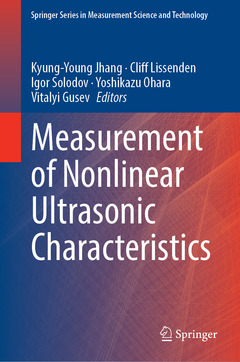Description
Measurement of Nonlinear Ultrasonic Characteristics, 1st ed. 2020
Springer Series in Measurement Science and Technology Series
Language: English
Subject for Measurement of Nonlinear Ultrasonic Characteristics:
Keywords
Ultrasonic Nonlinearity; Higher Harmonic Generation; Contact Acoustic Nonlinearity; Nonlinear Guided Wave; Nonlinear Frequency Mixing; Nonlinear Ultrasonic Phased Array; Nonlinear Frequency-Mixing Photoacoustic; nonlinear photoacoustics; Nonlinear Imaging of Defects; Elastic Nonlinearity; Subharmonic Generation
Publication date: 01-2020
Support: Print on demand
Publication date: 01-2021
287 p. · 15.5x23.5 cm · Paperback
Description
/li>Contents
/li>Biography
/li>Comment
/li>
Conventional ultrasonic methods based on ultrasonic characteristics in the linear elastic region are mainly sensitive to mature defects but are much less responsive to micro-damage or incipient material degradation. Recently, nonlinear ultrasonic characteristics beyond the linear ultrasonic amplitude range have been studied as a method for overcoming this limitation, and hence, many researchers are engaged in theoretical, experimental, and various application studies. However, the nonlinear ultrasonic characteristics are quite exacting compared to the linear phenomena so that they require vast experience and high proficiency in order to obtain proper experimental data. Actually, many researchers, especially beginners including graduate students, have difficulty in reliably measuring nonlinear ultrasonic characteristics. This book provides key technological know-how from experts with years of experience in this field, which will help researchers and engineers to obtain a clear understanding and high quality data in the nonlinear ultrasonic experiments and applications.
Preface
Chapter 1. Overviews: Nonlinear Ultrasonic Characteristics and Measurands
Chapter 2. Elastic Nonlinearity induced Nonlinear Ultrasonic Characteristics
2.1 Higher Harmonics (HH) Generation
2.2 Nonlinear Ultrasonic Parameters
2.2.1 Absolute Nonlinear Ultrasonic Parameter
2.2.2 Relative Nonlinear Ultrasonic Parameter
2.3 Measurement of Nonlinear Ultrasonic Parameter
2.3.1 Capacitive Detection and Laser-interferometric Detection
2.3.2 Piezo-electric Detection
2.3.3 Control of Propagation Distance and Control of Incident Wave Power
2.3.4 Phase Inversion Technique
2.4 Factors Affecting to Measurement Reliability
2.4.1 Measurement System: Transducer, Input Power, Contact Pressure, Electronic Equipment
2.4.2 Digital Signal Processings: Bandwidth of Incident Wave, Time Resolution, Amplitude Resolution
2.5 Applications to Assessment of Material Damage
2.5.1 Fatigue Damage2.5.2 Plastic Deformation
2.5.3 Thermal Aging
Chapter 3. Nonlinear Acoustic Wave Interactions with Contact Interfaces: Methodologies and Applications
3.1. Nonlinear Reflection Approach to Interface Nonlinearity
3.1.1 Nonlinear acoustic reflection at an ideally bonded interface
3.2.1 Application of Reflection Concept to Nonlinear Interface Wave Propagation
3.3.1 Second Harmonic Generation of Interface Acoustic Waves
3.2. Acoustic Nonlinearity of a Non-Bonded Interface
3.2.1 Phenomenology of Contact Acoustic Nonlinearity (CAN)
3.2.3 Nonlinear Acoustic Reflection by Fractured Defects
3.2.4 Acoustic Rectification and Nonlinear Polarization Effects via CAN
3.3. Non-Classical Nonlinear Effects in Resonant Contact Inclusions
3.3.2 Sub- and Super-harmonic Resonances
3.4. Applications for Nonlinear Imaging of Defects
3.4.1 Nonlinear Scanning Laser Vibrometry
3.4.2 Nonlinear Air-Coupled Emission (NACE)
3.4.3 Case Studies of Nonlinear Imaging of Defects
References
Chapter 4. Nonlinear Ultrasonic Phased Array for Measurement of Closed-Crack Depth
4.1. Introduction4.2. Harmonics
4.2.1. Principles
4.2.2. Experimental conditions
4.2.3. Imaging results
4.3. Parallel and sequential transmission
4.3.1. Principles
4.3.2. Experimental conditions
4.3.3. Imaging results
4.4. Full-, odd- and even-elements transmission
4.4.1. Principles
4.4.3. Imaging results
4.5. Utilization of thermal stress
4.5.1. Principles
4.5.2. Experimental conditions
4.5.3. Imaging results
References
Chapter 5. Nonlinear Guided Waves
5.1. Introduction
5.2. Background on guided wave propagation
5.3. Self Interaction
5.3.1. Basic principles
5.3.2. Lamb waves in plate
5.3.3. Shear horizontal waves in plate
5.3.4. Axisymmetric waves in pipe
5.3.5. Flexural waves in pipe5.4. Mutual interaction in plate
5.4.1. Basic principles
5.4.2. Collinear waves
5.4.3. Non-collinear waves
5.5. Actuation of primary waves and reception of secondary waves
5.5.1. Actuation of Lamb and L(0,n) waves
5.5.2. Actuation of SH and T(0,n) waves
5.5.3. Reception
5.5.4. Effects of diffraction
5.6. Signal processing
5.6.1. Fast Fourier transform
5.6.2. Phase inversion
5.7. Measurement considerations
5.7.1. Measurement nonlinearities
5.7.2. Material nonlinearity
5.7.3. Contact acoustic nonlinearity
5.7.4. Measuring progressive degradationReferences
Chapter 6. Nonlinear Frequency-Mixing Photoacoustic Characterization of aCrack
6.1. Introduction in nonlinear photoacoustics
6.1.1. An overview of NDT methods combining laser optics with nonlinear acoustics
6.1.2. Generation of the thermo-elastic stresses and of acoustic waves by modulation of cw-laser radiation
6.1.3. Influence of stationary laser heating on a crack6.2. Nonlinear frequency-mixing photo-acoustic method for crack detection
6.2.1. Principle of the method
6.2.2. One dimensional imaging of a crack
6.2.3. Two-dimensional imaging of a crack
6.2.4. Role of classical and nonclassical nonlinearities
6.3. Breathing and spatial resolution evolution with experimental parameters
6.3.1. Influence of the probe power
6.3.2. Influence of the pump power
6.3.3. Influence of the local crack parameters
6.4. Towards quantitative evaluation of local crack parameters
6.4.1. Experimental observations6.4.2. Theoretical model
6.4.3. Extraction of crack parameters
ReferencesPresents major nonlinear ultrasonic methodologies at a glance
Transfers key technological know-how, helping the reader to quickly acquire measurement skills
Provides many tips for getting significant data from nonlinear ultrasonic characteristics
An essential guidebook for all researchers and laboratories in the field of ultrasonic nondestructive evaluation




